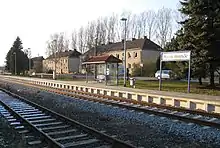Peenemünde
Peenemünde (German pronunciation: [peːnəˈmʏndə], English: "Peene [River] Mouth") is a municipality on the Baltic Sea island of Usedom in the Vorpommern-Greifswald district in Mecklenburg-Vorpommern, Germany. It is part of the Amt (collective municipality) of Usedom-Nord. The community is known for the Peenemünde Army Research Center, where the world's first functional large-scale liquid-propellant rocket, the V-2, was developed.
Peenemünde | |
|---|---|
 Seaport | |
 Coat of arms | |
Location of Peenemünde within Vorpommern-Greifswald district  | |
 Peenemünde  Peenemünde | |
| Coordinates: 54°08′N 13°46′E | |
| Country | Germany |
| State | Mecklenburg-Vorpommern |
| District | Vorpommern-Greifswald |
| Municipal assoc. | Usedom-Nord |
| Government | |
| • Mayor | Rainer Barthelmes |
| Area | |
| • Total | 24.97 km2 (9.64 sq mi) |
| Elevation | 3.0 m (9.8 ft) |
| Population (2021-12-31)[1] | |
| • Total | 343 |
| • Density | 14/km2 (36/sq mi) |
| Time zone | UTC+01:00 (CET) |
| • Summer (DST) | UTC+02:00 (CEST) |
| Postal codes | 17449 |
| Dialling codes | 038371 |
| Vehicle registration | VG |
| Website | www.amtusedomnord.de |
Geography

The village with its seaport is located on the westernmost extremity of a long sand-spit, where the Peene empties into the Baltic Sea, in the northwestern part of Usedom Island. To the southeast it borders on the sea resort of Karlshagen.
Peenemünde harbour can be reached by ferry boat across the Peene from Kröslin, liners also run along the Baltic coast to Rügen Island. The local railway station is the northern terminus of the Usedomer Bäderbahn line to Zinnowitz. Air service for the village is available at the Peenemünde Airfield.
History
During the 10th and 11th centuries, Peenemünde was part of the region of Circipania, an area settled by the Circipanes, a West Slavic tribe constituent of the Lutici federation. Circipania was incorporated into the Billung March of the Holy Roman Empire in 936, but the Empire's influence in the region decayed by the end of that century after a successful Slavic uprising. During the late 12th century, in the aftermath of the Wendish Crusade, the region fell under the rule of the Duchy of Pomerania. After the Treaty of Kremmen in 1236, most of Circipania was transferred to the Margraviate of Brandenburg.[2]
In World War II, the area was highly involved in the development and production of the V-1 and V-2 rockets, until the production's relocation to Nordhausen. The village's docks were used for the ships which recovered V-2 wreckage from test launches over the Baltic Sea. German scientists such as Wernher von Braun, who worked at the V-2 facility, were known as "Peenemünders". The resistance group around the priest Heinrich Maier passed on plans for the V-1, V-2 rockets, and the Peenemünde research station to the Allies. The resistance group, later discovered by the Gestapo, was in contact with Allen Dulles, the head of the US secret service OSS in Switzerland. The allied bombers were able to carry out precise air attacks with the sketches of the production facilities. The information was important for Operation Crossbow and Operation Hydra, both pre-missions for Operation Overlord. During Operation Hydra, the research facility was badly hit by the attack by the RAF bomber command on Peenemünde on the night of August 17–18, 1943. The attack was carried out by a total of 596 bombers (324 Avro Lancaster, 218 Handley Page Halifax, 54 Short Stirling). There was extensive destruction and the rocket launch of the prototype V-2 was delayed by about two months. 123 people died, including the scientist Walter Thiel. Wernher von Braun was able to save himself in a bunker.[3][4] The entire island was captured by the Soviet Red Army on 5 May 1945. The gas plant for the production of liquid oxygen still lies in ruins at the entrance to Peenemünde.
The post-war port was a Soviet naval base until turned over to the armed forces of East Germany in 1952. The seaport facilities were used at first by the East German Seepolizei (sea police) after new facilities for police motorboats had been built. On 1 December 1956 the headquarters of the First Fleet of the East German People's Navy was established at Peenemünde.
The Peenemünde Historical Technical Museum, a World War II museum on the European Route of Industrial Heritage opened in 1992 in the power station of the former Army Testing Site[5] and the area of the World War II power station (now part of the village). Exhibits include a V-1 and a V-2.
References
- "Bevölkerungsstand der Kreise, Ämter und Gemeinden 2021" (XLS) (in German). Statistisches Amt Mecklenburg-Vorpommern. 2022.
- Bucholz, Werner (1999). Pommern. Deutsche Geschichte im Osten Europas. Siedler, pp. 23ff. ISBN 3-88680-272-8
- Elisabeth Boeckl-Klamper, Thomas Mang, Wolfgang Neugebauer: Gestapo-Leitstelle Wien 1938–1945. Vienna 2018, ISBN 978-3-902494-83-2, p 299–305; Hans Schafranek: Widerstand und Verrat: Gestapospitzel im antifaschistischen Untergrund. Vienna 2017, ISBN 978-3-7076-0622-5, p 161–248; Fritz Molden: Die Feuer in der Nacht. Opfer und Sinn des österreichischen Widerstandes 1938–1945. Vienna 1988, p 122; Peter Broucek "Die österreichische Identität im Widerstand 1938–1945" (2008), p 163; Hansjakob Stehle "Die Spione aus dem Pfarrhaus (German: The spy from the rectory)" In: Die Zeit, 5 January 1996; Christoph Thurner "The CASSIA Spy Ring in World War II Austria: A History of the OSS's Maier-Messner Group" (2017), pp 187; Martin Middlebrook "The Peenemünde raid: the night of 17–18 August 1943" (1988).
- Operation Crossbow - Preliminary missions for the Operation Overlord
- "The Peenemünde Historical Technical Museum". Retrieved 8 December 2014.
External links
![]() Media related to Peenemünde at Wikimedia Commons
Media related to Peenemünde at Wikimedia Commons
![]() Peenemünde travel guide from Wikivoyage
Peenemünde travel guide from Wikivoyage
